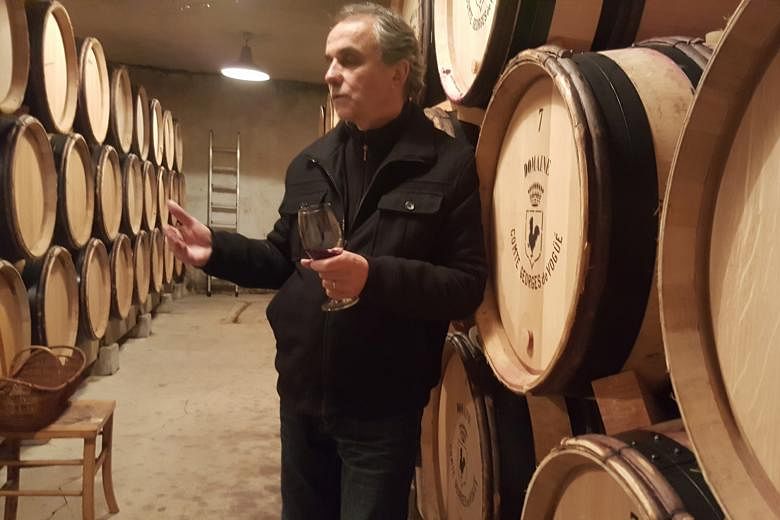(NYTIMES) - The pour among the rich is different from you and me - only they can afford grand cru burgundy.
That wasn't always the case.
In the 1990s, middle-class wine lovers could still afford to experience that rite of passage - drinking a truly great wine, not simply to enjoy it but also to understand what qualities made it exceptional in the eyes of history.
It was still feasible then, just as it was possible to buy first-growth Bordeaux, or the top wines of Barolo, Brunello di Montalcino or Napa Valley Cabernet Sauvignon, to name a few other standard-bearers. For example, back in 1994, a bottle of Comte Georges de Vogue Musigny 1991, a grand cru, retailed for US$80. Today, that bottle costs about US$800 (S$1,100).
In a more extreme case, Domaine de la Romanee-Conti La Tache 1990, another grand cru and one of the world's great wines, cost US$285 in 1993. Today, a bottle of the 2017 La Tache goes for about US$5,000, well out of reach for dedicated students of wine, except for the most wealthy.
For wine lovers, drinking such renowned bottles would be the equivalent of a college course in Shakespeare, Beethoven or Charlie Parker. In any field, it's necessary to comprehend the reference points, the benchmarks that connote greatness, to join that conversation even if ultimately you choose to argue the point.
These days, it is impossible for most people to pay for these wines.
You could argue that prices have risen on all sorts of consumer goods since then. Why should wine be different? You would not be wrong.
But the issue is not simply that prices in general have gone up. The prices of top wines have risen at a far steeper rate than the prices of many other luxury goods.
La Tache 2017 is almost 18 times as expensive as the 1990 vintage, while the price of a basic Hermes Birkin 30 bag, the grand cru of handbags, has gone from about US$3,000 in 1990 to US$11,000 this year, not quite four times as much.
Bordeaux operates on a slightly different scale from burgundy. Far more wine is produced.
But it, too, has its benchmark wines and, like burgundy, its prices have skyrocketed.
Princeton University's economics professor Orley Ashenfelter has closely tracked the Bordeaux market for years. In 1980, the price of a first-growth Bordeaux was roughly four times the price of a fifth-growth Bordeaux, he said, referring to an 1855 classification that ranked top Medoc producers in five tiers, or growths.
Now, he said, as prices have risen for all of these top wines, the ratio between first- and fifth-growth price is more like 10-to-1.
Partly, it's the good old law of supply and demand. Great wine is tied to finite pieces of land and to the rhythms of agriculture. With a limited quantity of grapes and only one opportunity to make wine each year, production cannot be increased to meet rising demand.
With the exception of certain top champagnes like Dom Perignon, which are not linked to particular vineyards, the best wines are not luxury goods such as watches or handbags in which production can grow to meet demand. Neither can production be kept artificially low, for that matter, to create demand.
Yet, even for a trophy wine like Dom Perignon, the relative price has gone up. A study published in 2017 in The Journal Of Wine Economics analysed champagne prices in New York City from 1948 to 2013 by determining how many hours people in various income groups would have to work to pay for an entry-level champagne, a mid-range bottle and a flagship or luxury cuvee like Dom Perignon.
The study found that the entry-level bottles across income groups required fewer work hours in 2013 than in 1948, but the hours necessary to buy luxury bottles had increased. What's more, the study found that the work hours required for a top champagne increased at a much higher rate for the lower-income groups relative to the highest, meaning that their access had diminished.
Today, wine lovers from around the world clamour for roughly the same pool of great burgundies that was available in 1990.
Fortunately, great wines are being produced all over the world nowadays. Those who are fascinated by how wine can express in intricate detail the characteristics of a place and culture can turn to German Rieslings, the Chenin Blancs of Savennieres, Chianti Classicos and Priorats.
They also have many other less expensive options, in places such as Burgundy and Bordeaux, wines that are highly pleasurable and offer a taste of what the fuss is about, even if they don't tell the full story.

